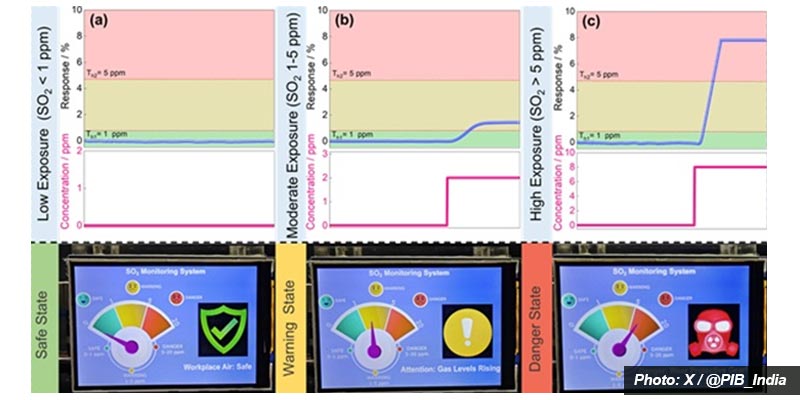- India
- Jul 05
- Sreesha V.M
Scientists develop new sensor to detect toxic sulfur dioxide in air
• A new low-cost sensor can help detect toxic sulfur dioxide (SO2) gas at extremely low concentrations.
• SO2 is a toxic air pollutant commonly released from vehicles and industrial emissions, and even minute exposure can cause serious health issues.
• SO2 irritates the skin and mucous membranes of the eyes, nose, throat, and lungs. High concentrations of SO2 can cause inflammation and irritation of the respiratory system, especially during heavy physical activity.
• The resulting symptoms can include pain when taking a deep breath, coughing, throat irritation, and breathing difficulties. High concentrations of SO2 can affect lung function, worsen asthma attacks, and worsen existing heart disease in sensitive groups.
• This gas can also react with other chemicals in the air and change to a small particle that can get into the lungs and cause similar health effects.
• Monitoring SO2 levels in real-time is crucial for public safety and environmental protection, yet existing technologies are often expensive, energy-intensive, or unable to detect the gas at trace levels.
• Scientists from Centre for Nano and Soft Matter Sciences (CeNS), Bengaluru, an autonomous institute of Department of Science and Technology (DST), fabricated a sensor by combining two metal oxides — nickel oxide (NiO) and neodymium nickelate (NdNiO3), through a simple synthesis process.
• While NiO acts as the receptor for the gas, NdNiO3 serves as the transducer that efficiently transmits the signal, enabling detection at concentrations as low as 320 ppb, far surpassing the sensitivity of many commercial sensors.
• To demonstrate the capabilities of this material, the team developed a portable prototype that incorporates the sensor for real-time SO2 monitoring.
• The prototype features a straightforward threshold-based alert system that activates visual indicators, green for safe, yellow for warning, and red for danger, allowing easy interpretation and response, even by users without scientific expertise.
• Its compact and lightweight design makes it suitable for use in industrial areas, urban locations and enclosed spaces where continuous air quality monitoring is necessary.
• With its high sensitivity, portability, and user-friendly operation, this sensor system offers a practical solution to monitor and manage SO2 pollution, supporting public health and environmental safety.
(The author is a trainer for Civil Services aspirants.)

